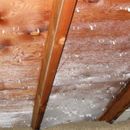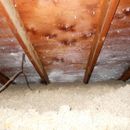Frost under roof deck
Once again, I turn to the experts to help me give advice to a utility customer for whom I did an energy assessment the other day. (northern Iowa, Climate Zone 6A) During the assessment, I checked insulation levels in the attic and found a significant amount of frost forming on the underside of the roof deck and the roofing nails themselves.
The customer does use a humidifier, but interior humidity wasn’t bad…about 45% when I was there.
They are looking to add to the existing 8″ of cellulose to get to R-50. Based on the presence of the frost, and the fact that I did not see any insulation baffles to keep the existing cellulose out of the soffits, I plan to advise the customer that the insulation contractor install enough baffles to help avoid the moisture buildup in the attic. Am I on the right track? The attached pictures will show you what I’m faced with.
GBA Detail Library
A collection of one thousand construction details organized by climate and house part











Replies
Curtis, The insulation and baffles are fine.
You are wrong however about the humidifier and 45%. Open homes like the one you are looking at will do just what this one is doing if the owners humidify. The water they add daily to the humidifier is right in your pictures. That being said, open airy homes many times can handle all that frost. As you can see, the plywood looks OK other than being frosted right? Right.
They have only one way to rid the attic of the frost. Stop putting it there with the humidifier.
I would suggest not using the humidifier or using it way less. And add the insulation and baffles, along with making sure the vents are in place.
Curtis,
You're right; ventilation baffles are called for.
More important than added insulation, however, is air sealing work. The frost is a clear sign that warm, humid air is probably leaking from the interior into the attic. It's time for an experienced weatherization contractor to peel back the insulation, find the air leaks, and seal them.
Thanks for the answers so far. The customer has an insulation contractor coming on Friday, so I'm trying to get my "advice" together before then.
I will talk to their contractor and tell them about the need for baffles and air sealing attic intrusions before they put down more cellulose. As far as the property owner and humidity, what % RH should I advise? As I mentioned they were at 45% (albiet according to their own humidity meter...I plan to get my own Fluke!). No condensation was noted on any of the exterior windows.
Curtis, I would just let them know to turn it down. Whatever they feel they can live with. Less to none is better than the amount they most likely are running it.
By the way, modern low ACH homes need no humidification where I post from. In fact they need proper ventilation such as bath fans and or HRVs to get rid of moisture.
I have a Fluke 971 and a Testo 610. They agree with each other within a percent or two. The $30 thermo-hygrometers that people have in their homes (and I have a few too) are always quite far off. That 45% that you were reading on your customer's unit could easily be 10% or more off in either direction. And, it's only in one spot in the house.